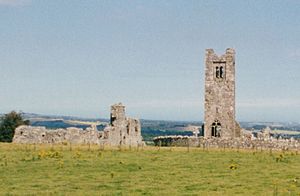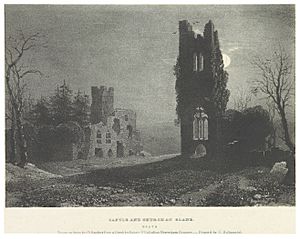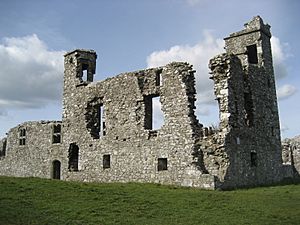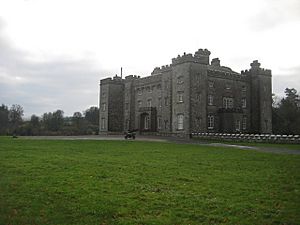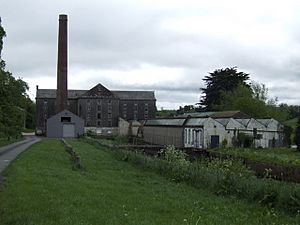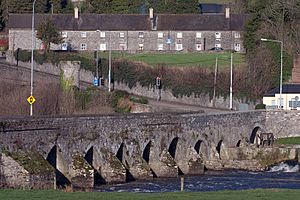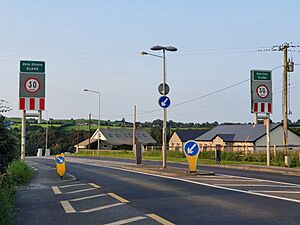Slane facts for kids
Quick facts for kids
Slane
Irish: Baile Shláine
|
|
|---|---|
|
Village
|
|
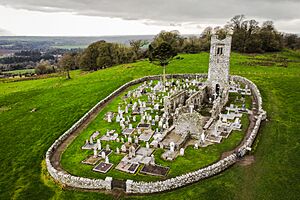
The ruins of the friary church on the hill of Slane.
|
|
| Country | Ireland |
| Province | Leinster |
| County | County Meath |
| Elevation | 64 m (210 ft) |
| Population
(2022)
|
1,445 |
| Irish Grid Reference | N959742 |
Slane (which means "Town of Sláine mac Dela" in Irish) is a village in County Meath, Ireland. It sits on a steep hillside next to the River Boyne. Two important roads, the N2 (from Dublin to Monaghan) and the N51 (from Drogheda to Navan), cross here. In 2022, Slane had 1,445 people living there. The village and its surroundings are full of old historical sites, some over 5,000 years old. The main part of the village you see today was mostly built in the 1700s.
Contents
Exploring Slane's Past
People have lived in the Slane area since at least the Stone Age. We know about early settlements on the Hill of Slane from old writings. The first buildings still standing in the village were made by the Norman family of Flanders (later Fleming). One of these is a motte and bailey, which is a type of castle mound, near the Hill of Slane.
Later, in the 1700s, the Conyngham family took over. They rebuilt Slane Castle and designed the village center to look like a model British village. This is a great example of 18th-century town planning.
In the middle of the village, you can see four almost identical Georgian houses. They stand where the two main streets meet, forming a shape that looks like an octagon. This area is called The Square. One of these houses used to be a police station and jail. The main streets have beautiful grey limestone buildings from the 1700s with slate roofs and special windows.
The village also has a place called "Gallows Hill." This is where people who fought for Irish independence in 1798 were publicly executed. This was done to try and stop others from rebelling. In 2007, the local council suggested protecting Slane village and its old mill as important historical areas.
Slane's Growing Population
Slane's population has grown quite a bit over the years. Between 1996 and 2016, the number of people living here doubled, from 699 to 1,369.
In 2006, there were 1,099 people in the village. If you include the nearby countryside, the total population was 1,587. A 2016 survey showed that most people (77%) who travel for work or school from Slane have a commute of less than one hour.
Sports and Games in Slane
Slane has a long history with sports. The first recorded inter-county match of caid, which is like modern Gaelic football, happened in Slane in 1712. A poet even wrote a long poem about it!
Today, the local Gaelic Athletic Association (GAA) club is called Slane Gaelic Football Club. Their home games are played at Toddy Harding Park, about 5 kilometers north of the village. Slane Wanderers is the village's local football (soccer) club, and they play at Wheatfield Park.
In 1979, Slane also hosted the first ever Irish Motocross Grand Prix.
Amazing Places to Visit
The Hill of Slane
North of the village, you'll find the Hill of Slane, which is 158 meters high. There are many old sites on top of this hill. Ancient stories say that an old king named Sláine mac Dela was buried here. There's a man-made mound on the western side of the hilltop. It's thought that a Christian church was built here because there was already an important ancient site.
A famous story says that Saint Patrick lit a special fire on this hilltop in 433 AD. This was to show his faith, even though the High King Laoire had forbidden any other fires while a festival fire was burning on the Hill of Tara. Historians believe Patrick lit a fire elsewhere, but the story moved to Slane because you can see the Hill of Tara from here (about 16 km away). The story says the King was so impressed that he let Patrick continue his work in Ireland. It's more certain that Patrick chose Saint Erc to be the first bishop of Slane.
The Hill of Slane was a center for religion and learning for many centuries. Old records say that in 948 AD, Vikings burned the bell tower of Slane, destroying many important items and killing people. Nothing is left of the tower today, but you can still see the ruins of a church and college on the hill. The church was rebuilt in 1512. The ruins include a 19-meter high tower. The friary was left empty in 1723.
The well-known Christian hymn Be Thou My Vision uses an old Irish folk song tune called Slane, which is about the Hill of Slane.
About 150 meters west of the church ruins, hidden by trees, are the remains of a 12th-century Norman motte and bailey. This was built by Richard Fleming in the 1170s. The Fleming family, who were lords of Slane, later moved to a castle on the River Boyne, which is where Slane Castle is today.
Slane Castle's History and Concerts
Slane Castle is about 1 kilometer upstream from the village center, right by the river. There's an ancient well on the castle grounds near the river. In old Irish stories, this well was said to have healing powers. Later, when Christianity came to Ireland, it became known as Our Lady's well. People still visit it for pilgrimages every August.
The castle grounds are famous for hosting huge rock concerts since 1981.
Also on the castle grounds are the ruins of St. Erc's Hermitage. This includes an old chapel, a dwelling, a stone bridge over a stream, and the quarry where the building materials came from. A local story says that a stone carving of the crucifixion was moved from this chapel to the modern church in the village in the 1800s, but it mysteriously returned to the Hermitage overnight! Part of a celtic cross carving from the Hermitage is now in Saint Patrick's Church on Chapel Street. This Catholic church was built around 1805. Don't confuse it with the similarly named Saint Patrick's Church of Ireland on Main Street, built in 1797.
In 2009, "Slane Castle Whiskey" started being made. It was a blended whiskey produced at a distillery outside Dundalk. Later, a new distillery called "Slane Castle Distillery" was built in 2017 by Brown Forman. It is owned by Henry and Alex Conyngham and produces "SLANE Irish Whiskey."
The Historic Slane Mill
In the 1760s, the Boyne Navigation opened, making the River Boyne navigable for small boats from Slane to Drogheda, about 10 km downstream. A series of canals were built for this. Once the navigation reached Slane, David Jebb built a large flour mill there. Slane Mill is on the north bank of the River Boyne, next to the N2 bridge. It's a five-story stone building. When it was finished in 1766, it was the biggest flour mill in Ireland!
The mill used the river's water to power its machinery, grinding flour until the 1870s. After that, it was used to process flax for clothing. As the textile industry changed, the mill shifted to making more finished goods. The workers moved to a "new mill" built uphill. The old water-powered mill then became a small power station, generating electricity.
By the late 1900s, like many textile mills in Europe, both Slane mills faced challenges. They struggled with new designs, competition, and cheaper labor elsewhere. The textile industry that once employed many people in Slane mostly disappeared.
Slane Bridge and Road Safety
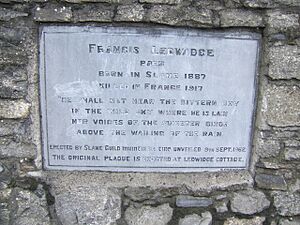
The N2 road crosses the River Boyne south of the village. The road goes down a steep hill from the village and then makes a very sharp turn onto a 14th-century bridge. This bend was very dangerous, causing at least 22 deaths in the late 20th century. If you look at the wall on the right side of the road as you go up the hill, you'll see small white crosses, each marking a death. Many accidents involved large trucks that couldn't slow down enough for the sharp turn after speeding up on the hill.
Local authorities have added many safety measures to make the bend safer. These include separate traffic lights for trucks and cars, and a 30 km/h speed limit throughout the village. Since these changes, there have been no more fatal accidents. It was hoped that the M1 motorway would take a lot of heavy traffic away from the village. However, some trucks still use the N2 and Slane bridge to avoid paying tolls on the M1 bridge. Plans for a bypass around Slane were rejected in 2012 because it would have affected the view of the nearby Newgrange monument, a UNESCO World Heritage site.
Historical Sites Near Slane
There are many other historical places around Slane. The Brú na Bóinne complex of ancient burial tombs is on the River Boyne, about 5 km downstream. This includes Newgrange, a famous passage tomb built around 3200 BC.
Across the river from the old mill are the ruins of Fennor Castle/Tower House, next to Fennor Church and its graveyard.
The ruins of Castle Dexter, built around the 12th century, are about 2 kilometers west of Slane Castle, also near the River Boyne. Old drawings of this castle are kept in the National Library of Ireland.
You can also find old lime kilns dotted around the hills of Slane. The most visible ones are behind the village's only service station and near Ledwidge Cottage.
The Rosnaree Mill has a special stone carving called a Sheela na gig. It has been moved indoors to protect it from the weather. You can see it by asking the owner at George's Patisseries on Chapel Street in Slane.
The site of the famous Battle of the Boyne is 10 km downriver, east of Slane.
Getting Around Slane
Bus Éireann route 190 connects Slane to Drogheda, Navan, Trim, Mullingar, and Athlone. Buses run every hour in each direction to/from Navan, Trim, and Drogheda, and every two hours to Athlone. Collins Coaches also run a route linking Slane to Dublin, Collon, Ardee, and Carrickmacross. McConnons also offer a few services daily.
People from Slane
Many interesting people have come from Slane:
- John Cassidy (1860–1939), a painter and sculptor.
- Dean Cogan (1826–1872), a Catholic historian who wrote about the Diocese of Meath.
- John Connolly (1750–1825), who became the second Bishop of the Roman Catholic Diocese of New York.
- Francis Ledwidge (1887–1917), a poet who died in World War I.
- Denis Nulty (1963-), the current Catholic Bishop of Kildare and Leighlin.
- John Boyle O'Reilly (1844–1890), a poet, publisher, and member of the Irish Republican Brotherhood.
See also
 In Spanish: Slane para niños
In Spanish: Slane para niños




